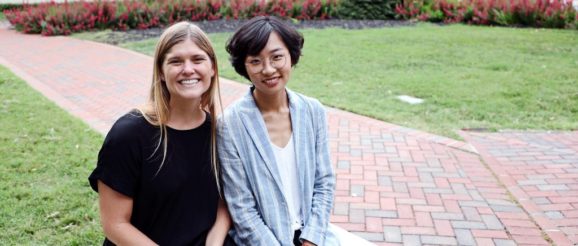Inventory and Innovation: Fellows lay groundwork for coastal master plan

A chance to ‘shape their communities’
When Anna-Beth Lawler first heard about Governor Ralph Northam’s executive order for a coastal resilience master plan, she never expected to be in a position to contribute towards the plan’s formation.
But as a coastal adaptation and protection fellow, Lawler collaborated with Phillips and two other Sea Grant fellows to begin the master plan. Lawler, a University of Virginia master’s student in urban planning, worked along two other fellows trained in architecture and environmental science.
“They were working with professors and really exposed at a high professional level already,” Phillips said. “That’s the beauty of this, is working with young people who are at the master’s level, they have tremendous exposure already.”
In the plan’s early stages of development, Phillips and the fellows collaborated with planning district commissions and local organizations to understand each region’s unique needs and the projects they have already started to prepare.
“Coastal resiliency challenges are different for every locality,” Lawler said. “Their vulnerabilities and their challenges are going to be different depending on where they are.”
Lawler, who grew up in the Northern Neck region of coastal Virginia, has seen these changes firsthand.
“There have been water quality changes in the rivers we grew up swimming in, changes in storm frequencies, the flooding challenges,” Lawler said. “In the water in front of my house, we used to catch completely different fish species than we’re catching now—It’s things like that.”
As part of her fellowship, Lawler and the other two fellows working with Phillips on the master plan have also visited sites affected by sea level rise and flooding, including the NASA flight facility on Wallops Island and the Pamunkey Museum and Cultural Center.
Another large component of the master plan will identify critical infrastructure and culturally important areas, determine how vulnerable these coastal resources are, and recommend some general guidelines for coastal adaptation going forward.
“Everyone wants to feel a sense of belonging and to shape their communities, and planning is a great way to think about these short and long-term decisions,” Lawler said.
They’ve also compiled a list of funding sources, with the assistance of Wetlands Watch, that are available to the state and local governments.
After completing her summer fellowship, Lawler returned to finish her master’s degree in urban planning at UVA. She said the plans she had helped prepare prior to this fellowship “felt like you were preparing something that was just to check a box and then would get dusty on a shelf. This plan will have more real-world application. More people will have access to it,” she added.
Through the fellowship, Lawler has met the many professionals invested in Virginia’s coastal resilience—from scientists to community leaders and lawyers—but also developed a network of early career graduate students who are passionate about resilience.
“It’s been nice being part of the Virginia Sea Grant community,” Lawler said. “When we’re having Skype meetings, we wave to the other Sea Grant fellows, and it just feels like we have this community of young professionals trying to figure out where we belong in the world.”
TAKEAWAYS
Photos and Video by Aileen Devlin | Virginia Sea Grant
Written by Madeleine Jepsen | Virginia Sea Grant
Published May 4, 2020.
